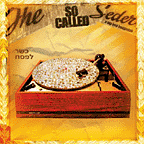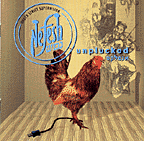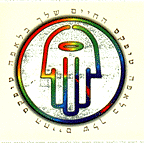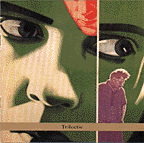For more information:
Note that the latest stuff may not yet be indexed.
The Klezmer Shack directory of articles
Fresh Music for Passover
Lori Cahan-Simon Ensemble / Songs my bubbe should have taught me, vol. one: Passover, 2001
SoCalled / The SoCalled Seder, 2001
Nefesh / Unplucked, 2001
Tea Packs / Your life in a lafa, 1995
Jewlia Eisenberg / Trilectic, 2001
This is the sort of set of reviews that reminds me how much different music we're listening to now. Today's reviews include on new album of Yiddish secular song for Passover, one American klezmer album, one avant garde, mostly a capella album, an Israeli album of vaguely Mizrahi persuasion, and a hip hop seder. Enjoy!
 Lori Cahan-Simon Ensemble / Songs my bubbe should have taught me, vol. one: Passover, 2001 Available from cdbaby.com/cd/lcahan.
Lori Cahan-Simon Ensemble / Songs my bubbe should have taught me, vol. one: Passover, 2001 Available from cdbaby.com/cd/lcahan.
Oh, what fun! At a time when secular Jewish organizations such as Workmen's Circle are finding new purpose, and at a time when the Yiddish revival is helping to ensure a new, if small, generation of Yiddish speakers, this collection of wonderful Passover Yiddish songs is most welcome. But, hey, who says you need to be Yiddish to enjoy? A few of the songs have familiar melodies, as on "Eliahu Hanavi," or "Dayenu" but now the text sung is in Yiddish. (Okay, so "Dayenu" contains some untraditional riffs in the spirit of four cups of wine. This is a great Dayenu, as the best of families sing it!) The selections are taken from the secular Haggadahs of the various Yiddish school systems in the US. None of this music should have been forgotten.
Cahan-Simon is accompanied by some of the best klezmorim and singers, around, including Cleveland's own Steven Greenman (Khevrisa, et al), Alex Fedoriouk and Walt "Vlado" Mahovlich, Pittsburgh's own Henry Shapiro on bass, as well as Michael Alpert (Brave Old World, just to begin with the credits). In some cases, the music is simply captivating (as if that isn't enough), as on the duet between Cahan-Simon and Alpert on "Der bekher" (The goblet), or Greenman's and Fedoriouk's interplay on this new setting for "Avadim Hayinu" (we were slaves). Other pieces, such as "Miriam's gezang" (Miriam's song), by St. Petersburg Conservatory founder Anton Rubinstein, represent the vital Yiddish art song tradition. And then, hearing the fier kashes (four questions) in yiddish, with a brand new, audience-participatory tune, makes me impatient for the seder, so I can teach the new tune and chorus to all.
The album is accompanied by copious notes, yiddish transliterations, and english translation. It's almost time for Passover, true, but even if your copy doesn't arrive in time for this year's holiday, you'll have almost a year to learn the new songs, so that next year, you won't have to complain about those songs that bubbe should have sung to you. Many thanks to Ms. Cahan-Simon, and to the whole gang, for making this wonderful recording, and for making it so wonderful.
Abbi Wood wrote the following review to the jewish-music mailing list:
Date: Fri, 15 Mar 2002
From: Abbi WoodDear all,
Just wanted to add my enthusiasm to the general warm reactions to Lorele's new CD. I received my copy a few weeks ago and it's been playing fairly constantly since. As others have mentioned, this is an important recording in itself as a contribtion to the available recorded repertory of Yiddish song. However, don't be led into thinking that this is some kind of 'dry' archival recording. The songs are presented in fresh, skilful arrangements (by Steven Greenman), showcasing the considerable talents of Lori, Michael Alpert and Greenman himself, and conveying some of the pure enthusiasm of these artists for the material.
Lori is a versatile singer, moving comfortably between vocal styles, from a rich deep sound on 'Eliyohu hanovi' to an intimate whisper on 'Peysakh avek', an attractive lullaby-style song anticipating Shavuot. My personal favourite track is 'Tayere Malke', where the nine verses of the song, performed by both Lori and Michael Alpert (using Warshawsky's melody) are interspersed by traditional klezmer tunes, which bring the whole song into one long dance set: it's clear from the recording that all involved had a lot of fun recording this.
Had I time to write more, I'd mention some stunning tsimbl moments, a solo track by Michael Alpert, some great songs I'd never heard before, nicely produced liner notes... but I really don't have time... So, to wind up - this CD is a real pleasure to listen to.
 SoCalled / The SoCalled Seder, 2001 (self-published).
SoCalled / The SoCalled Seder, 2001 (self-published).
For another take on the seder, we offer this often-interesting, and always quite different hip hop "so-called seder". I'm not sure all of the album stands out--sometimes the vocals are mixed so far back, the album serves more as background than as text. But when things are on, as on the "four questions" it is witty fun. Even numbers that could have been tightened up, like "Let my people go" are at least interesting ("Nice people don't drink on Pesakh????"). The whole production is casual, and certainly sets a high bar for the next hip hop seder. This isn't crisp enough to knock "Hip Hop Hoodíos" off the number one spot in my heart, but it makes for a holiday-relevant, fun second. Now, let's all stay cool and calm, until Mr. Dolgin releases the SoCalled Kol Nidre service
 Nefesh / Unplucked, 2001.
Nefesh / Unplucked, 2001.
Nefesh has been playing all over Connecticut for the last few years. In addition to their music, they have been active promoting Yiddish dance. In this first release, the band showcases its versatility, moving from klezmer favorites such as the "Odessa Bulgar" and Naftule Brandwein's "Sie bist die gewesen vor prohibition?" (where were you before prohibition). In addition, the band covers Yiddish folk favorites, ranging from "Sha Shtil" to "Yidl mitn fidl" and some Israeli and Sephardic favorites, as well. There are even a few band originals, including a touching new Yiddish child's lullaby in Yiddish. The music arrangements are very much of our time and place, as exemplified by "Dror Yikra," in which it sounds as though the tsimbl is being used to percussively mark time during the verse chanting, and then solos a bit during the break. All in all, this is an exemplary outing by an American klezmer band showing its breadth.
 Tea Packs / Your life in a lafa, 1995, Hed Artzi 15708. Write: Tea Packs, PO Box 400, Ramat Gan, Israel 52103
Tea Packs / Your life in a lafa, 1995, Hed Artzi 15708. Write: Tea Packs, PO Box 400, Ramat Gan, Israel 52103
I feel like I'm slowly discovering this new underground. Someone comes up and says, "hey, have you heard this Israeli band, Tipex?" "What about those tea packs, eh?" So, finally, garnering some recommendations, I have my brother pick up a copy at a local record store and drop it by. This is the most fun I've had with Israeli music in years. The band is witty, biting. The music is a delightful fusion of Israeli Mizrahi pop, with Eastern and Western rock and hip hop and traditional influences all over. The instrumentation ranges from electronics to bagpipes, and everything requisite in between. I haven't had so much fun since Poogy, but this is Poogy for people who grew tired of ketzef 20 years ago. It's like Atraf 3, but deeper, less urgent. It's like a grown up borekas band for thinking folks. I dunno. This is just wonderful. The band was originally based in one of the development towns. The name, transliterated by the band into English, "tea packs" is actually the name for "whiteout" in Hebrew. Yeah, we Mizrahi kids in development towns are really visible. "I used to get off at the old stop / and it was like being in a different state / a country of reality on hold / when rain falls and when the sun burns...." The best part about this, at least for me, is that I'm coming to this late. When I'm ready, I can go to my local Judaica shop and there will be lots more of these to catch up on. This is the second album I've heard, and they seem to be all different and all wonderful. "I have a girlfriend ... / when I am with her / I am totally different, / dream of a car / and electrical appliances, / because she has a nose / and beautiful eyes / and a red smile / just like in the advertisements...." Sheesh, even the illustrations accompanying the songs are funny serious commentary. And, have I already talked about the music and the lovely Mizrahi vocals? The main vocalist is very good, but when Sharon Ben Zadok sings, "I need to know if this is love," with that perfect quaver in her voice, I'm in love. This is the album I listen to most this month. It was the album I discovered last month. I'm likely to keep listening for a long time. You can pick up your copy, and if you're at all interested in good music, especially good, Israeli music. Ari Bob says, "check it out. This is the one."
 Jewlia Eisenberg / Trilectic, 2001, Tzadik, TZ7155. www.tzadik.com
Jewlia Eisenberg / Trilectic, 2001, Tzadik, TZ7155. www.tzadik.com
This is an amazing and interesting album. I was already a fan of Eisenberg's work in the Charming Hostess, but here she takes vocal traditions and history and weaves something uniquely worth listening to. Imagine Zap Mama and Bulgarian village music unleashed on Walter Benjamin. No, this is better than even that. It seems that Walter Benjamin spent considerable time in 1926 - 1927 in Moscow, in love with propagandist Asja Lacis. Two radical human beings were in love (or one was in love, one enjoyed being loved) during revolutionary times. The texts are taken from the writings of both. Sometimes the words that Eisenberg has set to music can seem near profound: "I can be here in your bed. I can go to a café. But I can't be in your bed and go to a café--that's too serious." Sometimes they are wistful: "Will I always look at the moon and think of Asja?" Sometimes they are entirely trivial. But just as the music, primarily a capella, covers almost every form of singing and woman's voice, the picture of Benjamin and Lacis, in the end, makes the lives and time real. For most of us, that means that Lacis exists for the first time (not altogether as an admirable presence) and Benjamin is, perhaps, something less than the Marxist theologian he can appear to be.
This is a very special album. It is an experiment and an exposition into being revolutionary and human. Eisenberg's voice, and musical imagination are a pleasure, and worth hearing even without pondering the words and the fragments of relationship they describe. Enjoy!

